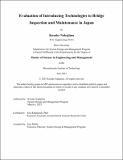Evaluation of Introducing Technologies to Bridge Inspection and Maintenance in Japan
Author(s)
Nakajima, Kosuke
DownloadThesis PDF (34.80Mb)
Advisor
Rebentisch, Eric
Terms of use
Metadata
Show full item recordAbstract
This study investigates the current problems in bridge inspection and maintenance in Japan and explores how the technologies can help address the problems. The literature reviews and interviews with bridge owners identify the potential problems and needs of the bridge owners in chapter 2. Chapter 3 broadly explains the technologies, such as data collection devices, and introduces the digital twin concept as a potential solution in the future to approach the identified problems. While DT might work for bridge inspection systems, the data analytics capability of DT, such as machine learning, cannot provide an accurate outcome enough to replace manual inspectors’ ability due to the insufficient amount of training data. Also, quantitative data such as displacements and acceleration have not been collected since the devices have not yet been installed on bridges. Therefore, Chapters 4 and 5 explore the potential combinations of the data collection devices to provide the best values to bridge owners by performing tradspace analyses. Chapter 4 provides the data sources of the technologies used in the tradespace study. Chapter 5 presents the outcome of the tradespace analysis and the insights. The insights from the interviews and the tradespace analysis are summarized in the following:
Interviews
• Small municipalities have more issues than large ones, such as lack of budget, technical personnel, and skills and experience.
• The identified needs are increased budget, improved efficiency, improved quality, and a safer work environment.
Tradespace
• The utility curve increases as more technologies are adopted, so adopting technologies could provide new values to bridge owners. However, costs increase more significantly than utilities do, as the slope of the curve is close to a flat. The tradespace model considers only a few PMs to evaluate the potential benefits of technologies, so the increase in utilities is modest compared to the increase in costs.
• The high costs often result from expensive fixed devices such as displacement meters, accelerometers, etc.
Based on the above insights, the author suggests recommendations, including improvement of knowledge and experience in bridge owners, effective uses of technologies, and increased financial support from the government. The author argues that an in-house inspection or a hybrid form of an in-house and outsourced inspection might work well for small municipalities with limited budgets and resources.
Date issued
2023-06Department
System Design and Management Program.Publisher
Massachusetts Institute of Technology